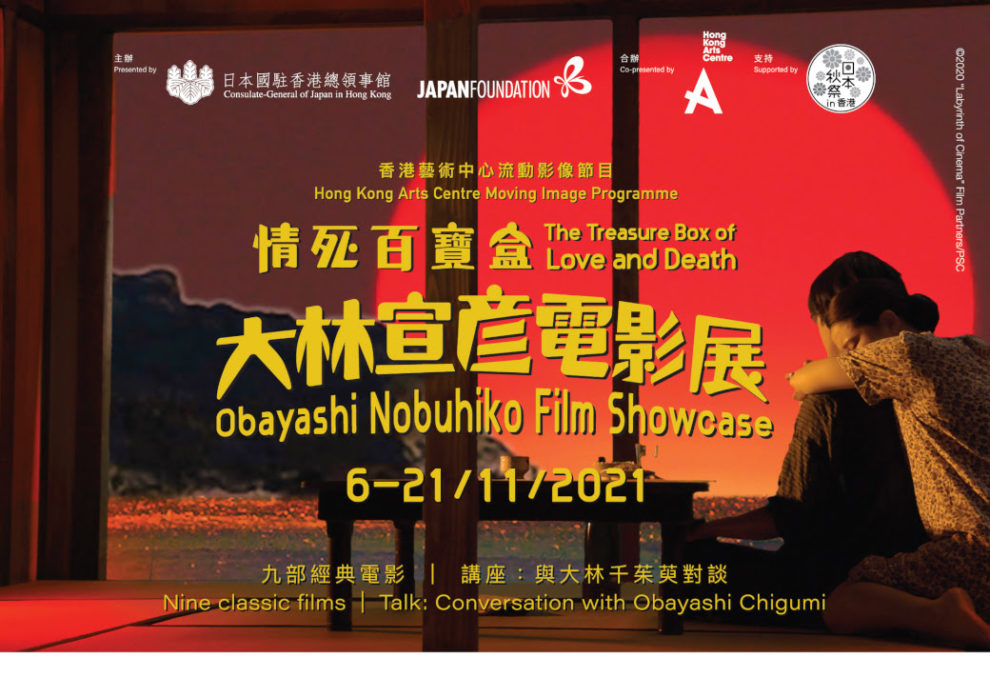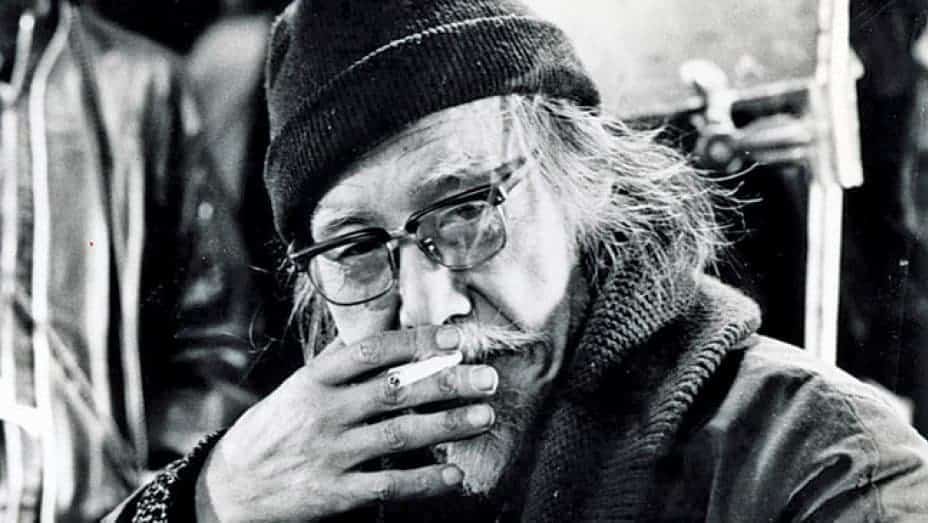Venue: Louis Koo Cinema, Hong Kong Arts Centre
Date: 2021.11.06 – 2021.11.21
Price: Tickets are now available at URBTIX
Japanese director Obayashi Nobuhiko, who died in April last year, is probably one of the most difficult audiovisual auteurs to categorise. From experimental films to TV commercials and mainstream features, he has left behind a large number of works with diverse themes in different fields. He is well known for his imaginative visual imageries, while the locations in which his films take place often become “pilgrimage sites” for film buffs.
Presented by the Consulate-General of Japan in Hong Kong and The Japan Foundation, co-presented by the Hong Kong Arts Centre and supported by Japan Autumn Festival in Hong Kong – Rediscovering Nippon, moving image programme The Treasure Box of Love and Death: Obayashi Nobuhiko Film Showcase commemorates this magical film artist, screening nine selected features by Obayashi, including four rarely seen works from the 1980s, from which audiences can observe various motifs found in Obayashi's films: home, playfulness, pacifism and the tragedy of love.
Screening Schedule
6/11 (Sat) 2:30pm Emotion + The Ruined City
6/11 (Sat) 7:30pm The Strange Couple
7/11 (Sun) 2pm House
7/11 (Sun) 4pm Four Sisters
7/11 (Sun) 7:30pm The Young and Wild*
9/11 (Tue) 7:30pm Seven Weeks
10/11 (Wed) 7:30pm Hanagatami
21/11 (Sun) 2pm Labyrinth of Cinema
21/11 (Sun) 5:35pm Talk: A Conversation with Obayashi Chigumi
*With after-screening talk. Conducted in Cantonese.
Emotion
“I've returned your heart, yet I've lost my own.”
Japan | 1967 | 40' | In Japanese with English subtitles | 16mm | Colour
A pretty young woman travels from a seaside village to a city, where she meets a city girl before encountering and falling in love with a mysterious vampire. A homage to Roger Vadim's Blood & Roses, the film is narrated by Japanese film scholar Donald Richie. Emotion is Obayashi's most famous short film during his experimental phase, and had been shown at 60% of universities in Japan.
The Ruined City
“I'm nothing at all.”
Japan | 1967 | 40' | In Japanese with English subtitles | 16mm | Colour
- Ninth place (Top 10 Japanese Films of All Time), Kinema Junpo 1984
A university student visits a remote town famed for its canals in order to work on his undergraduate dissertation. He is immediately attracted to the young girl running the guesthouse in which he stays, and is enchanted by the constant sound of the waters. However, to the locals, this charming and laid-back small town is a dying and ruined city, and the large guesthouse and the family living within it are in a state of tragic decline. Obayashi Nobuhiko filmed this art film in two weeks during the summer holidays with a mini crew as well as the participation of local residents, and used 16mm film to capture the unique scenery of Yanagawa, successfully recreating the “private novel” atmosphere of Fukunaga Takehiko's book upon which the film is based. This is the first film in which Kobayashi Satomi plays a leading role, as well as being pre-war star Irie Takako's final work.
The Strange Couple
“Let's live on with patience although our dream is broken.”
Japan | 1988 | 108' | In Japanese with English subtitles | 16mm | Colour
- Nominated for Best Director and Best Art Direction, Japan Academy Film Prize 1989
Debt collector Murota lives with his wife Yuko in a small town by the sea, but following the release of their childhood friend from jail and his rejoining of the yakuza, the relationship between Murota and Yuko undergoes a subtle change. At this time, a cinema by the seaside prepares for its last movie show. Adapted from a manga by Yamasaki Juzo, Obayashi Nobuhiko used Agfa film to shoot this film, creating a colourful palette rarely seen in Japanese films by capturing trains running in the middle of a busy city, as well as the dirty and haphazard small houses along the coast, portraying an atmosphere of Onomichi city that is at once absurd and unique. The film within a film interspersed throughout is Lily from Shanghai (Shima Koji, 1952), and Obayashi even convinced that film's leading man to come out of retirement to play a part, forming an interesting filmic dialogue.
House
“The bright sunlight frightens me.”
Japan | 1977 | 88' | In Japanese with English subtitles | 16mm | Colour
A young girl, unhappy with her father's decision to remarry, decides to bring along six of her friends to spend the summer with her aunt who lives in the mountain. Unbeknownst to them, the aunt had died many years ago while waiting for her fiancé to return but that her spirit remains, eating unmarried girls who arrive at her home. The idea for the plot came from Obayashi's 12-year-old daughter, which combines elements of the Hollywood blockbuster Jaws with Japanese horror tales. Blending elements of teen drama, comedy and horror, this gory, terrifying yet funny and playful work represents Obayashi's first foray into narrative films, and marks his return to filmmaking after more than a decade making commercials. The box-office success of House also paved the way for other independent filmmakers to venture into mainstream features.
Four Sisters
“We're closer than blood ties. We're the true sisters.”
Japan | 1985 | 100' | In Japanese with English subtitles | 16mm | Colour
- Nominated for Best Supporting Actress, Japan Academy Film Prize 1987
The story of four sisters of the Kitosawa family from Kyoto who, as it turns out, are not blood relatives, tracing the romantic and familial relationships of the women along with their trials and tribulations as they experience the various vicissitudes of life. In the 1980s, Obayashi Nobuhiko was widely seen as a director specialising in teen idol films, directing many rising stars in their film debuts and breakthrough hits. This film stars four popular young stars of the day, Konno Misako, Asano Atsuko, Sawaguchi Yasuko and Tomita Yasuko, and Four Sisters was seen as an updated version of the classic film The Makioka Sisters when it was released. However, unlike its gentle and delicate predecessor, Obayashi's work, adapted from Oyama Kazuhide's teen manga, starts out as lighthearted and playful but takes on a tragic life and death weightiness towards the end, running the full gamut of emotions from joyfulness to tears.
The Young and Wild
“Liar! Cheat! Apologise!”
Japan | 1986 | 135' | In Japanese with English subtitles | 16mm | Colour
- Sponichi Grand Prize New Talent Award, Mainichi Film Awards 1987
- Best Rediscoveries, Boston Society of Film Critics Awards 2015
The story of The Young and Wild takes place in a town located near the Seto Inland Sea in the days before the outbreak of World War II. A young boy is transferred to a primary school in the area and quickly starts a battle with his classmates to decide who will be the king of the children. Meanwhile, his beautiful older sister Osho-chan becomes the object of desire among all the male students, teachers, and even a young army officer, who compete with each other for her affection. When they find out that she is about to be sold to prostitution, all the men in town unite to save her… Made to commemorate the 10th anniversary of PSC, the production company founded by Obayashi Nobuhiko, The Young and Wild was adapted from Sato Haruo's semi-autobiographical novel, Wanpaku Jidai. By shifting the time period from the Russo-Japanese War to WWII, the film combines a jovial style with profound ruminations about war, and represents the start of a series of films with anti-war themes from the director.
*The Young and Wild after-screening talk
Veteran film critic Cheng Chuen-wai will attend the after-screening talk. (Conducted in Cantonese. No registration required; free admission. Limited seats available on a first-come, first-served basis.)
Seven Weeks
“Maybe a person's karma lives on in future generations.”
Japan | 2014 | 171' | In Japanese with English subtitles | DCP | Colour
- Fourth place (Top 10 Japanese Films of All Time), Kinema Junpo 2014
- Special Award, Japanese Professional Movie Awards 2014
Obayashi Nobuhiko served as the “principal” of the “Ashibetsu Film School”, a film event organised by the town of Ashibetsu in Hokkaido, and this film was financed independently, with 80% of the budget raised from residents in the area. The story follows the events after the death of Suzuki Mitsuo, a retired doctor who passed away at the age of 95. His children gather from all over Japan to attend his funeral. It transpired that after his retirement, Suzuki had turned his home into a secondhand store, and between the first funeral ceremony seven days after his death and the seventh one held 49 days afterwards, his children fight over what to do with the old things scattered throughout his house, stirring up memories about World War II and Korean miners. The dead and the living, past and present intersperse throughout the film, along with the verses of the poet Nakahara Chuya, invoking a faint sense of nostalgia that harks back to the bitter memories of war.
Hanagatami
“I'd like to live.”
Japan | 2017 | 168' | In Japanese with English subtitles | DCP | Colour
- First runner-up (Top 10 Japanese Films of All Time) and Best Director, Kinema Junpo 2017
- Best Film, Mainichi Film Awards 2017
Just prior to the outbreak of the Pacific War, Toshihiko, a seventeen-year-old high school student, moves in with his aunt in Karatsu, and soon develops tumultuous friendships with his classmates and infatuations with his younger cousin as well as other local beauties. However, his youthful recklessness and budding romances are soon swallowed up by war. Adapted from House on Fire author and protagonist Dan Kazuo's debut novel, Hanagatami was actually written before Obayashi Nobuhiko's first narrative feature, House, and only went into production 40 years later.

Talk: A Conversation with Obayashi Chigumi
Obayashi Nobuhiko's daughter, Obayashi Chigumi, will attend a virtual talk to chat about Director Obayashi's film journey and its stories with the audience.
Labyrinth of Cinema
“Peace to the world!”
Japan | 2019 | 179' | In Japanese with English subtitles | DCP | Colour
- Special Mention: AQCC-Camera Lucida Prize Fantasia Film Festival 2020
- Winner: Best Director Kinema Junpo Awards 2021
- Special Achievement Award, Tokyo International Film Festival 2019
On its last night of operation before closing down for good, a seaside cinema features a programme of Japanese war movies. A young female cinephile and her three friends are suddenly transported into the silver screen where they encounter Miyamoto Musashi, Ryoma Sakamoto and the Shinsengumi and experience social turbulence and war within a celluloid universe. As Obayashi's swan song, Labyrinth of Cinema is a summation of his main creative themes and styles, containing his reflections about cinema, war and his memories of growing up. Using the director's hometown of Onomichi as the starting point, the film explores the labyrinth of history in a meanderingly humorous way. Obayashi persists with his signature experimental style until the very end of his life, offering up a rich and kaleidoscopic cinematic treasure box.















